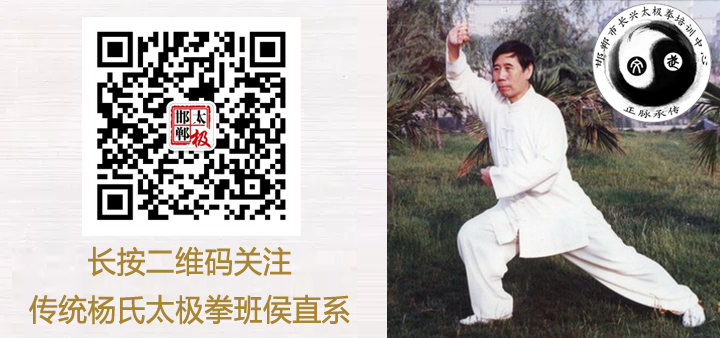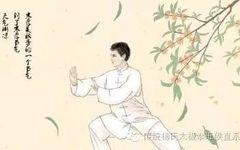First, Practice Calmness
Do not be overly excited; keep your mind clear and relaxed as if preparing to rest. Adjust your posture correctly and roughly go through the major points once or twice—it’s okay if you don’t get it perfect. Just avoid slouching, puffing your chest, or leaning forward or backward. Some friends wish to practice today and see results tomorrow; let me pour some cold water on that idea. Internal martial arts, like planting a tree, require months and years of diligent practice to succeed. Wanting to achieve it all at once will only lead to failure.
Second, Practice Relaxed Shoulders
Imagine your arms are dislocated, hanging loosely from your body. Gently sway your body side to side to see if your arms feel like willow branches swaying in the wind. This is the first step; if you get this right, everything else will follow smoothly. Some friends skip this step and go straight to the waist and hips, as if trying to jump from the first floor to the third.
Third, Practice Finding Sensation
First, find the sensation of heaviness in your hands. Slowly experience whether your hands feel heavy or swollen. If not, continue to work on relaxing your shoulders. Once you feel the heaviness in your hands, it’s like touching the door; at this point, you should practice diligently and not be inconsistent.
Fourth, Practice Shoulder Blade Contact
Once your hands feel heavy, your shoulders will further relax. At this point, you should feel whether your shoulder blades are making contact. This will also create a state of a hollow chest and rounded back. Initially, when you make contact, your chest, back, and shoulders may feel tense. In this state, relax again. You may experience some discomfort as the muscles in your chest and back, which usually remain inactive, begin to awaken. Don’t be afraid; adjust actively, and once you get through it, you will reach a new level. Shaking it out is a good way to naturally adjust.
Fifth, Practice the Waist and Abdomen
Once the principles of a hollow chest and rounded back are established, and the feeling of relaxed shoulders and heavy hands persists, begin adjusting the Mingmen (Gate of Life) area. At this point, you will also experience the turning of the hips and the rolling of the lower abdomen. In the earlier steps, just relax your waist; now you can start moving it. A reminder for beginners: the hips should be inward, not lifted.
Sixth, Practice Hip Rotation
When the hips are rotated to a certain extent, it may feel like they cannot rotate further. At this point, squat down slightly, with the intention of lifting your knees. This will allow the hips to rotate further, and you may also feel your toes gripping the ground. I won’t elaborate too much on this; I’ve talked about it before, and not many have managed to practice it. However, those who put in the effort have found it themselves. It seems the key lies in the practice. This process is long; you can explore it each time, but don’t expect to master it all at once; take it step by step. Don’t focus too much on your breathing; just keep it smooth. If you find your breathing is not smooth, it indicates that what you are trying to achieve exceeds your body’s capacity. You should reduce the intensity or strengthen the training from the previous stage. Ultimately, it boils down to four words: “The Great Way is Simple.” Avoid arrogance and impatience; just practice diligently. The technical system of internal martial arts is simpler than calligraphy, painting, or acrobatics. Many past masters were farmers, drivers, or craftsmen with little education, yet they achieved mastery and wisdom through practice. So everyone should have confidence; if you persist for an hour every day, you will surely succeed.

A Good Method to Enhance Internal Power in Tai Chi
The fundamental principle of Tai Chi practice is to concentrate the spirit, use intention rather than force, and allow the process to flow gently. The end of each movement is referred to as the “landing point” or “fixed position” in Tai Chi theory.
The correctness of the landing point practice is crucial in determining the formation of Tai Chi’s internal strength, which is also the secret of Tai Chi training.
The specific operational points of the “hard landing point” require that at the landing point (fixed position) of each Tai Chi movement, when it is about to stop (approximately one inch or less), a brief moment of internal strength should be maintained. The practitioner’s awareness should guide the internal energy from the Jiaoji (交脊穴) to the forearms, palms, and fingers.
Here, the guidance is to first relax and then tighten, which is the transformation from “void to solid” (the void and solid correspond to yin and yang). After finishing one movement and before starting the next, there should be a folding at the turning point, transitioning from tight to loose, and loosening to the extreme.
After the next movement begins, gradually transition from loose to tight, from void to solid. Relaxation is the main focus during the process, reflecting the requirement of “soft over strength.” The process of “soft over strength” should have more relaxation time than landing point time, and the movement process must be light and gentle.
The “hard landing point” process is brief (a few seconds or even shorter), and at the landing point (fixed position), the body must be calm and filled with internal strength (muscle tension is minimal and localized, aimed at guiding the internal energy).
At the landing point (fixed position), it is essential to achieve “sitting the wrist” and “relaxing the fingers.” Practitioners may not fully appreciate the importance of “sitting the wrist” and “relaxing the fingers.” Try performing the “sitting the wrist” and “relaxing the fingers” actions, and you will immediately feel the tightening of the wrist muscles, which is actually the initial sensation of internal strength. Through this conscious practice, day by day, you will gradually cultivate the internal strength of Tai Chi.
From the perspective of Qigong, if practitioners can achieve “sitting the wrist” and “relaxing the fingers,” they have unconsciously guided their internal energy to the “end point” of the arms through their brain’s awareness (everyone has internal energy, but it is generally imperceptible without practice), and the internal energy accumulates at the point of strength.“End point” refers to the position of the “strength point” in the movement, which should be combined with specific actions.
For example, in the Tai Chi “Raising Hands” movement, the “strength point” is at the front end of the middle of the forearm. Under the influence of awareness, the practitioner’s internal energy is continuously guided to the end of the limbs, and the amount of internal energy at the strength point increases, leading to changes in the internal structure of the arm, such as increased bone density and hardness. Practitioners will feel an increasing heaviness in their arms, and the movements will gradually become stable and relaxed.
Understanding the methods of “soft over strength” and “hard landing point” for the upper body in Tai Chi, the methods for the lower body are fundamentally the same. You should also guide the internal energy down from the Jiaoji (交脊穴) through the Mingmen (命门穴), waist, thighs, calves, and finally to the soles, roots, and toes of the feet. The landing point for the feet is called “rooting.”
“Rooting” is primarily guided by awareness; at the movement’s landing point (fixed position), the toes should be relaxed, the foot should have the intention of “sitting,” and the heels should have the awareness of “entering the ground three feet deep.”
After practicing according to the above methods to a certain level, you can further train any part of the body. For a specific area (like the abdomen’s Dantian) or a point (like a fingertip), practice according to the requirements of “soft over strength” and “hard landing point.”
During standing postures or sitting meditation, you can incorporate this method for practice, which will enhance the accumulation of internal energy. If you focus on a specific point on the body, you can use your intention to relax that point, then transition from loose to solid, i.e., “first void then solid,” or “first solid then void,” alternating back and forth in your mental training, gradually achieving the ability to differentiate between void and solid, yin and yang, in every part of the body, ultimately reaching a higher level of Tai Chi practice.

If there are any copyright issues, please contact the original author through the backend.The articles posted are for learning reference only. Please practice under the guidance of a professional teacher.

Official website: http://www.yunshuiwang.com



